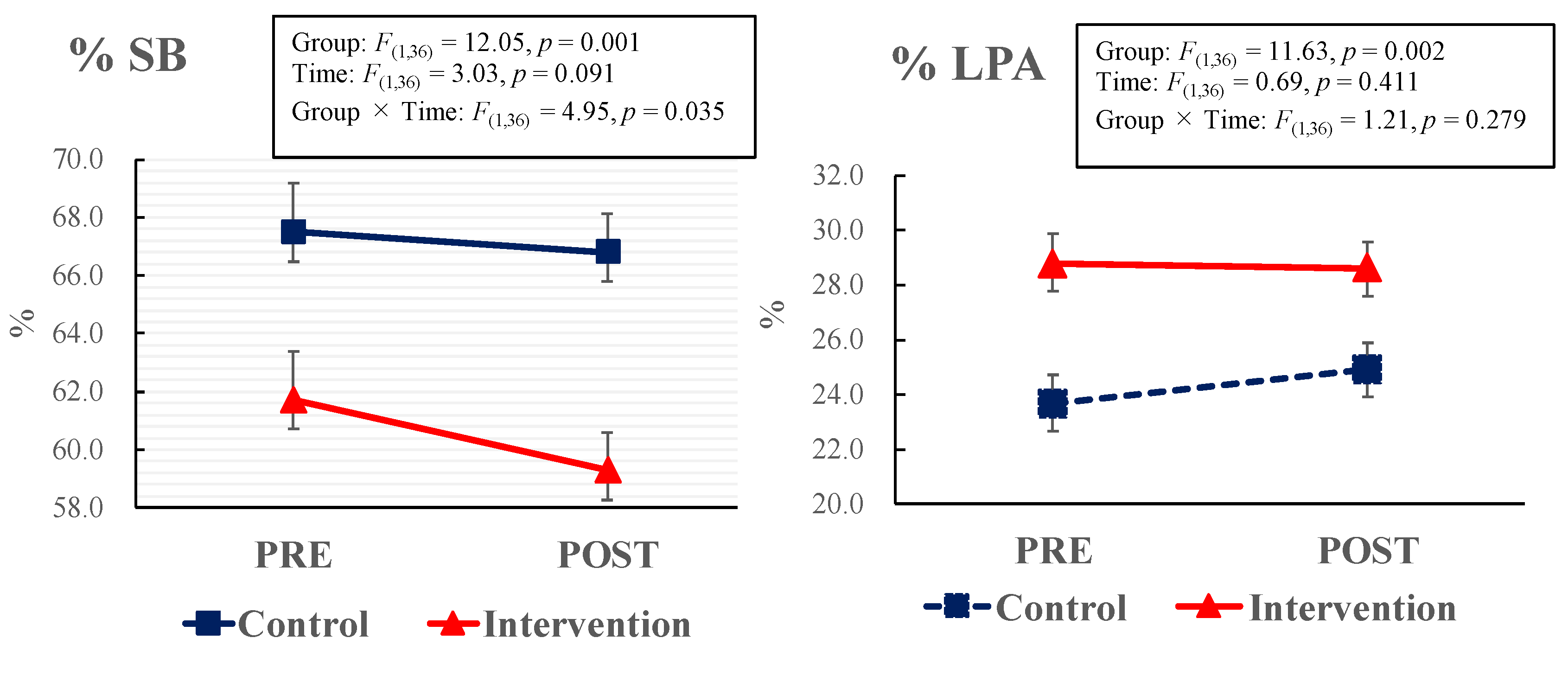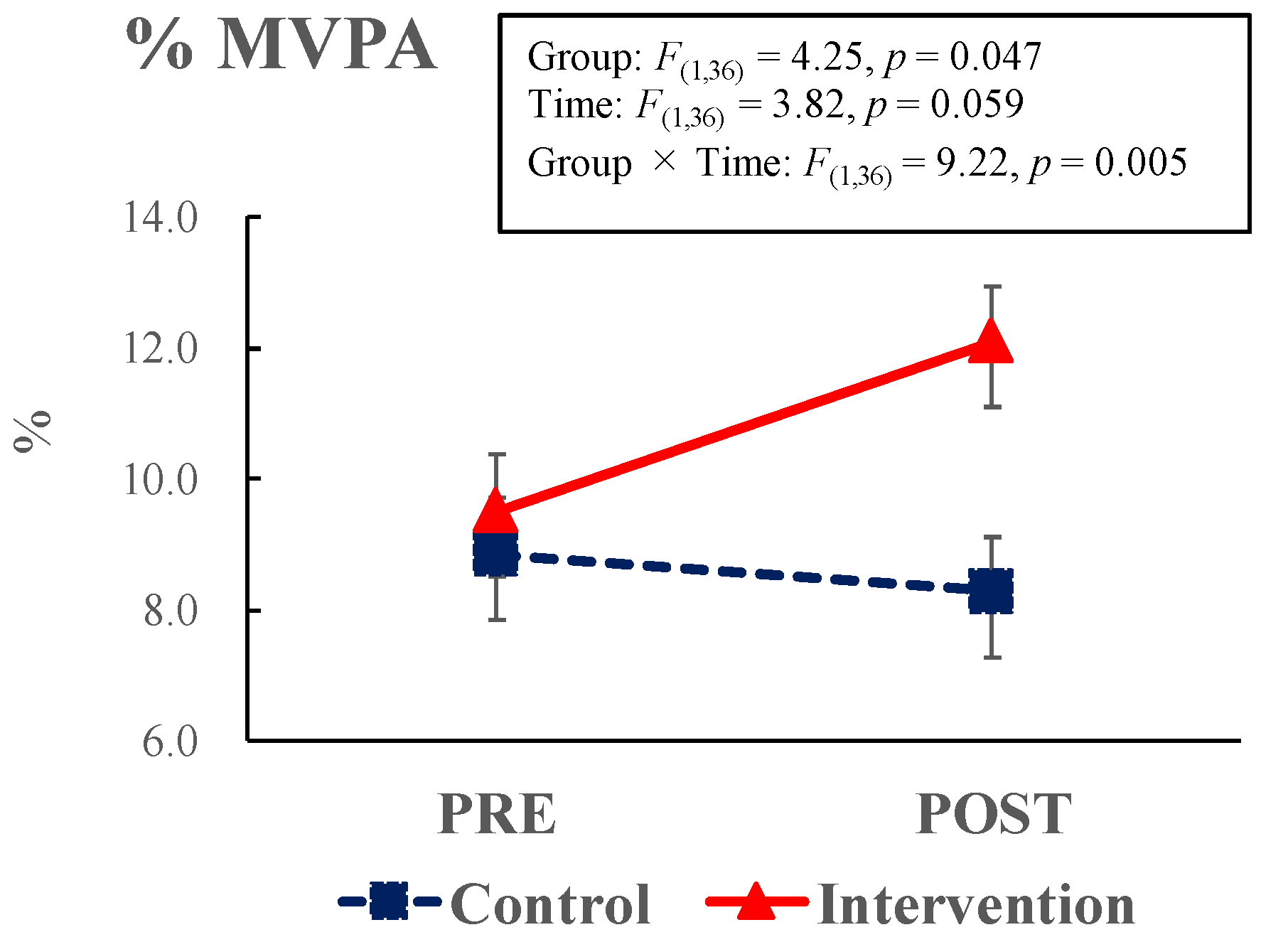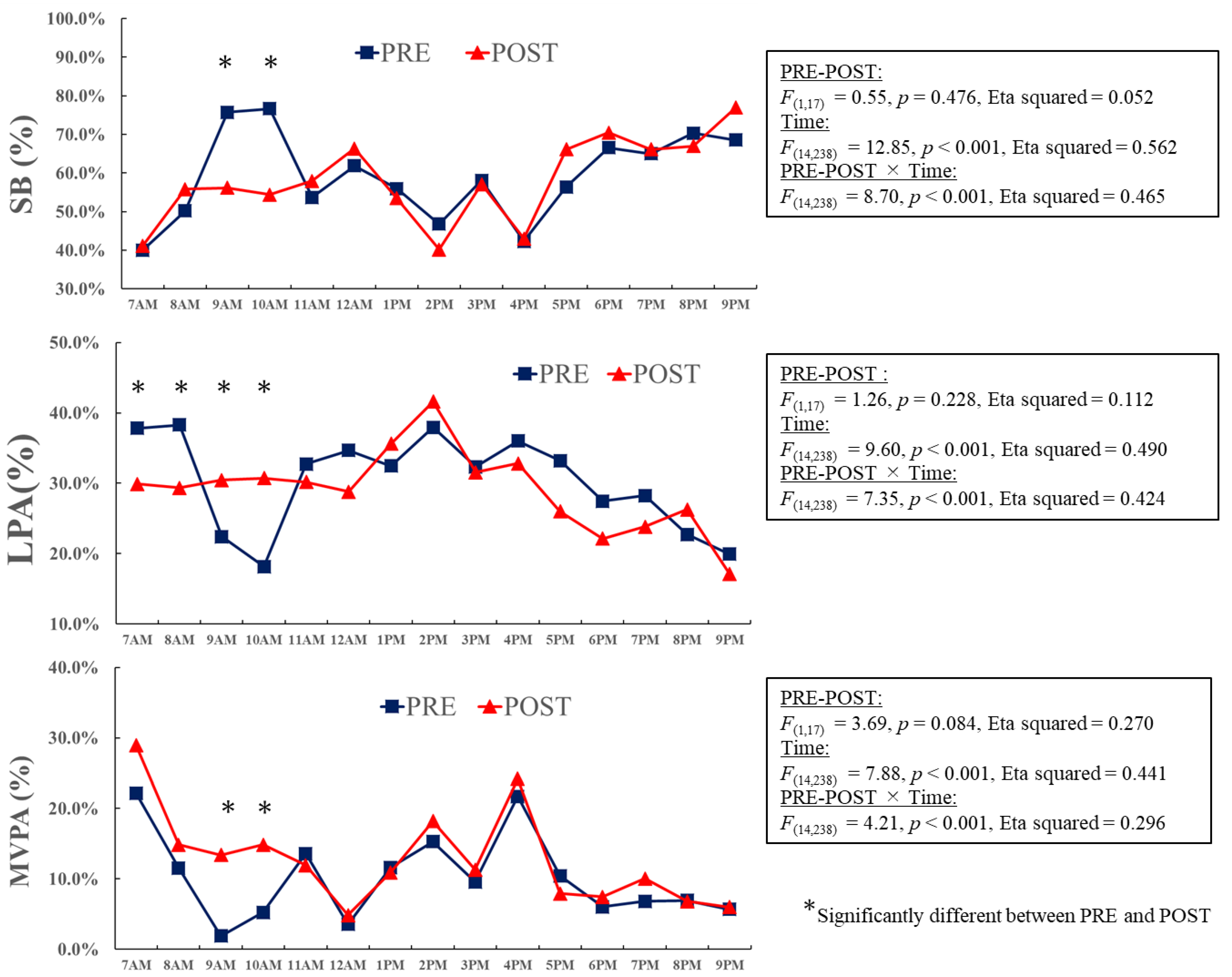Classroom Standing Desks and Time-Series Variation in Sedentary Behavior and Physical Activity among Primary School Children
Abstract
1. Introduction
2. Materials and Methods
2.1. Participants
2.2. Study Design
2.3. Measurements
2.4. Questionnaire Data
2.5. Data Analysis
3. Results
4. Discussion
5. Conclusions
Author Contributions
Funding
Acknowledgments
Conflicts of Interest
References
- Tremblay, M.S.; Aubert, S.; Barnes, J.D.; Saunders, T.J.; Carson, V.; Latimer-Cheung, A.E.; Chastin, S.F.M.; Altenburg, T.M.; Chinapaw, M.J.M. Sedentary Behavior Research Network (SBRN)—Terminology Consensus Project process and outcome. Int. J. Behav. Nutr. Phys. Act. 2017, 14, 75. [Google Scholar] [CrossRef] [PubMed]
- Owen, N.; Healy, G.N.; Matthews, C.E.; Dunstan, D.W. Too much sitting: The population health science of sedentary behavior. Exerc. Sport Sci. Rev. 2010, 38, 105–113. [Google Scholar] [CrossRef]
- Ishii, K.; Shibata, A.; Oka, K. Work Engagement, Productivity, and Self-Reported Work-Related Sedentary Behavior Among Japanese Adults: A Cross-Sectional Study. J. Occup. Environ. Med. 2018, 60, e173–e177. [Google Scholar] [CrossRef]
- Tremblay, M.S.; LeBlanc, A.G.; Kho, M.E.; Saunders, T.J.; Larouche, R.; Colley, R.C.; Goldfield, G.; Connor Gorber, S. Systematic review of sedentary behaviour and health indicators in school-aged children and youth. Int. J. Behav. Nutr. Phys. Act. 2011, 8, 98. [Google Scholar] [CrossRef] [PubMed]
- Carson, V.; Hunter, S.; Kuzik, N.; Gray, C.E.; Poitras, V.J.; Chaput, J.P.; Saunders, T.J.; Katzmarzyk, P.T.; Okely, A.D.; Connor Gorber, S.; et al. Systematic review of sedentary behaviour and health indicators in school-aged children and youth: An update. Appl. Physiol. Nutr. Metab. 2016, 41, S240–S265. [Google Scholar] [CrossRef]
- Biddle, S.J.; Pearson, N.; Ross, G.M.; Braithwaite, R. Tracking of sedentary behaviours of young people: A systematic review. Prev. Med. 2010, 51, 345–351. [Google Scholar] [CrossRef]
- Pearson, N.; Salmon, J.; Campbell, K.; Crawford, D.; Timperio, A. Tracking of children’s body-mass index, television viewing and dietary intake over five-years. Prev. Med. 2011, 53, 268–270. [Google Scholar] [CrossRef]
- Sakamoto, N.; Gozal, D.; Smith, D.L.; Yang, L.; Morimoto, N.; Wada, H.; Maruyama, K.; Ikeda, A.; Suzuki, Y.; Nakayama, M.; et al. Sleep Duration, Snoring Prevalence, Obesity, and Behavioral Problems in a Large Cohort of Primary School Students in Japan. Sleep 2017, 40. [Google Scholar] [CrossRef]
- Abbott, R.A.; Straker, L.M.; Mathiassen, S.E. Patterning of children’s sedentary time at and away from school. Obesity 2013, 21, E131–E133. [Google Scholar] [CrossRef]
- Ridgers, N.D.; Salmon, J.; Ridley, K.; O’Connell, E.; Arundell, L.; Timperio, A. Agreement between activPAL and ActiGraph for assessing children’s sedentary time. Int. J. Behav. Nutr. Phys. Act. 2012, 9, 15. [Google Scholar] [CrossRef] [PubMed]
- Clemes, S.A.; Barber, S.E.; Bingham, D.D.; Ridgers, N.D.; Fletcher, E.; Pearson, N.; Salmon, J.; Dunstan, D.W. Reducing children’s classroom sitting time using sit-to-stand desks: Findings from pilot studies in UK and Australian primary schools. J. Public Health 2016, 38, 526–533. [Google Scholar] [CrossRef]
- Aminian, S.; Hinckson, E.A.; Stewart, T. Modifying the classroom environment to increase standing and reduce sitting. Build. Res. Inf. 2015, 43, 631–645. [Google Scholar] [CrossRef]
- Hinckson, E.A.; Aminian, S.; Ikeda, E.; Stewart, T.; Oliver, M.; Duncan, S.; Schofield, G. Acceptability of standing workstations in elementary schools: A pilot study. Prev. Med. 2013, 56, 82–85. [Google Scholar] [CrossRef]
- Verloigne, M.; Ridgers, N.D.; De Bourdeaudhuij, I.; Cardon, G. Effect and process evaluation of implementing standing desks in primary and secondary schools in Belgium: A cluster-randomised controlled trial. Int. J. Behav. Nutr. Phys. Act. 2018, 15, 94. [Google Scholar] [CrossRef]
- Dornhecker, M.; Blake, J.; Benden, M.; Zhao, H.; Wendel, M. The Effect of Stand-biased Desks on Academic Engagement: An Exploratory Study. Int. J. Health Promot. Educ. 2015, 53, 271–280. [Google Scholar] [CrossRef]
- Mehta, R.K.; Shortz, A.E.; Benden, M.E. Standing Up for Learning: A Pilot Investigation on the Neurocognitive Benefits of Stand-Biased School Desks. Int. J. Environ. Res. Public Health 2015, 13, 59. [Google Scholar] [CrossRef]
- Wick, K.; Faude, O.; Manes, S.; Zahner, L.; Donath, L. I Can Stand Learning: A Controlled Pilot Intervention Study on the Effects of Increased Standing Time on Cognitive Function in Primary School Children. Int. J. Environ. Res. Public Health 2018, 15, 356. [Google Scholar] [CrossRef]
- Benden, M.E.; Blake, J.J.; Wendel, M.L.; Huber, J.C., Jr. The impact of stand-biased desks in classrooms on calorie expenditure in children. Am. J. Public Health 2011, 101, 1433–1436. [Google Scholar] [CrossRef]
- Wendel, M.L.; Benden, M.E.; Zhao, H.; Jeffrey, C. Stand-Biased Versus Seated Classrooms and Childhood Obesity: A Randomized Experiment in Texas. Am. J. Public Health 2016, 106, 1849–1854. [Google Scholar] [CrossRef]
- Clemes, S.A.; Bingham, D.D.; Pearson, N.; Chen, Y.L.; Edwardson, C.; McEachan, R.; Tolfrey, K.; Cale, L.; Richardson, G.; Fray, M.; et al. Stand Out in Class: Restructuring the classroom environment to reduce sedentary behaviour in 9-10-year-olds—Study protocol for a pilot cluster randomised controlled trial. Pilot Feasibility Stud. 2018, 4, 103. [Google Scholar] [CrossRef]
- Ministry of Education, Calture, Sports, Science and Technology, Japan. Curriculum Guideline for Primary School. Available online: http://www.mext.go.jp/a_menu/shotou/new-cs/youryou/syo/index.htm (accessed on 21 May 2019).
- Evenson, K.R.; Catellier, D.J.; Gill, K.; Ondrak, K.S.; McMurray, R.G. Calibration of two objective measures of physical activity for children. J. Sports Sci. 2008, 26, 1557–1565. [Google Scholar] [CrossRef]
- Freedson, P.; Pober, D.; Janz, K.F. Calibration of accelerometer output for children. Med. Sci. Sports Exerc. 2005, 37, S523–S530. [Google Scholar] [CrossRef]
- Masse, L.C.; Fuemmeler, B.F.; Anderson, C.B.; Matthews, C.E.; Trost, S.G.; Catellier, D.J.; Treuth, M. Accelerometer data reduction: A comparison of four reduction algorithms on select outcome variables. Med. Sci. Sports Exerc. 2005, 37, S544–S554. [Google Scholar] [CrossRef]
- Trost, S.G.; Pate, R.R.; Freedson, P.S.; Sallis, J.F.; Taylor, W.C. Using objective physical activity measures with youth: How many days of monitoring are needed? Med. Sci. Sports Exerc. 2000, 32, 426–431. [Google Scholar] [CrossRef]
- Cohen, J. Statistical Power Analysis for the Behavioral Sciences; Routledge: Abingdon-on-Thames, UK, 2013. [Google Scholar]
- WHO. Global Recommendations on Physical Activity for Health; World Health Organization: Geneva, Switzerland, 2010. [Google Scholar]
- Buman, M.P.; Winkler, E.A.; Kurka, J.M.; Hekler, E.B.; Baldwin, C.M.; Owen, N.; Ainsworth, B.E.; Healy, G.N.; Gardiner, P.A. Reallocating time to sleep, sedentary behaviors, or active behaviors: Associations with cardiovascular disease risk biomarkers, NHANES 2005–2006. Am. J. Epidemiol. 2014, 179, 323–334. [Google Scholar] [CrossRef]
- Moller, N.C.; Tarp, J.; Kamelarczyk, E.F.; Brond, J.C.; Klakk, H.; Wedderkopp, N. Do extra compulsory physical education lessons mean more physically active children--findings from the childhood health, activity, and motor performance school study Denmark (The CHAMPS-study DK). Int. J. Behav. Nutr. Phys. Act. 2014, 11, 121. [Google Scholar] [CrossRef]
- Kriemler, S.; Meyer, U.; Martin, E.; van Sluijs, E.M.; Andersen, L.B.; Martin, B.W. Effect of school-based interventions on physical activity and fitness in children and adolescents: A review of reviews and systematic update. Br. J. Sports Med. 2011, 45, 923–930. [Google Scholar] [CrossRef]
- Metcalf, B.; Henley, W.; Wilkin, T. Effectiveness of intervention on physical activity of children: Systematic review and meta-analysis of controlled trials with objectively measured outcomes (EarlyBird 54). BMJ 2012, 345, e5888. [Google Scholar] [CrossRef]
- Sudholz, B.; Timperio, A.; Ridgers, N.D.; Dunstan, D.W.; Baldock, R.; Holland, B.; Salmon, J. The Impact and Feasibility of Introducing Height-Adjustable Desks on Adolescents’ Sitting in a Secondary School Classroom. Aims Public Health 2016, 3, 274–287. [Google Scholar] [CrossRef]
- Biddle, S.J.; Petrolini, I.; Pearson, N. Interventions designed to reduce sedentary behaviours in young people: A review of reviews. Br. J. Sports Med. 2014, 48, 182–186. [Google Scholar] [CrossRef]
- Altenburg, T.M.; Kist-van Holthe, J.; Chinapaw, M.J. Effectiveness of intervention strategies exclusively targeting reductions in children’s sedentary time: A systematic review of the literature. Int. J. Behav. Nutr. Phys. Act. 2016, 13, 65. [Google Scholar] [CrossRef]
- Pearson, N.; Braithwaite, R.E.; Biddle, S.J.; van Sluijs, E.M.; Atkin, A.J. Associations between sedentary behaviour and physical activity in children and adolescents: A meta-analysis. Obes. Rev. 2014, 15, 666–675. [Google Scholar] [CrossRef]
- Ainsworth, B.E.; Haskell, W.L.; Herrmann, S.D.; Meckes, N.; Bassett, D.R., Jr.; Tudor-Locke, C.; Greer, J.L.; Vezina, J.; Whitt-Glover, M.C.; Leon, A.S. 2011 Compendium of Physical Activities: A second update of codes and MET values. Med. Sci. Sports Exerc. 2011, 43, 1575–1581. [Google Scholar] [CrossRef]
- Contardo Ayala, A.M.; Salmon, J.; Timperio, A.; Sudholz, B.; Ridgers, N.D.; Sethi, P.; Dunstan, D.W. Impact of an 8-Month Trial Using Height-Adjustable Desks on Children’s Classroom Sitting Patterns and Markers of Cardio-Metabolic and Musculoskeletal Health. Int. J. Environ. Res. Public Health 2016, 13, 1127. [Google Scholar] [CrossRef]
- Blazar, D.; Kraft, M.A. Teacher and Teaching Effects on Students’ Attitudes and Behaviors. Educ. Eval. Policy Anal. 2017, 39, 146–170. [Google Scholar] [CrossRef]
- Schwarzfischer, P.; Gruszfeld, D.; Socha, P.; Luque, V.; Closa-Monasterolo, R.; Rousseaux, D.; Moretti, M.; Mariani, B.; Verduci, E.; Koletzko, B.; et al. Longitudinal analysis of physical activity, sedentary behaviour and anthropometric measures from ages 6 to 11 years. Int. J. Behav. Nutr. Phys. Act. 2018, 15, 126. [Google Scholar] [CrossRef]




| Children’s Perceptions | Strongly Agree | Agree | Disagree | Strongly Disagree |
|---|---|---|---|---|
| Attitude to the standing desks | ||||
| I like using the standing desk during class (% (n)) | 16.7 (3) | 50.0 (9) | 27.8 (5) | 5.6 (1) |
| I want to continue using the standing desk (% (n)) | 27.8 (5) | 44.4 (8) | 16.7 (3) | 11.1 (2) |
| In the standing desk classroom… | ||||
| I can express my thoughts more effectively (% (n)) | 5.6 (1) | 61.1 (11) | 22.2 (4) | 11.1 (2) |
| It is easier to work (% (n)) | 44.4 (8) | 33.3 (6) | 11.1 (2) | 11.1 (2) |
| I am fatigued (% (n)) | 5.6 (1) | 5.6 (1) | 38.9 (7) | 50.0 (9) |
| I feel less sleepy (% (n)) | 55.6 (10) | 38.9 (7) | 5.6 (1) | 0 (0) |
| Standing Desk Usage | Mean ± SD or (% (n)) |
|---|---|
| Frequency | |
| Average standing desk use time (min/day) | 21.4 ± 5.9 |
| Average frequency of posture change during a class (time/class) | 1.8 ± 0.8 |
| In which subject do you stand up the most? (Multiple choices) | |
| Mathematics (% (n)) | 5.6 (1) |
| Social studies (% (n)) | 77.8 (14) |
| Japanese language (% (n)) | 94.4 (17) |
| Science (% (n)) | 0 (0) |
| English (% (n)) | 0 (0) |
| Music (% (n)) | 0 (0) |
| Home economics (% (n)) | 0 (0) |
| Technical course (% (n)) | 0 (0) |
| Ethics (% (n)) | 66.7 (12) |
| Calligraphy (% (n)) | 44.4 (8) |
| Art and Handcraft (% (n)) | 50.0 (9) |
| When do you stand up the most? (Multiple choices) | |
| During morning activities (% (n)) | 0 (0) |
| When I feel sleepy (% (n)) | 22.2 (4) |
| When I feel tired (% (n)) | 11.1 (2) |
| When I want to concentrate (% (n)) | 16.7 (3) |
| During group activities (% (n)) | 94.4 (17) |
| When I read a book | 22.2 (4) |
| When I write | 22.2 (4) |
| When I make handicrafts | 44.4 (8) |
| When I draw a picture | 0 (0) |
| When I perform calculations (% (n)) | 0 (0) |
| When I talk with a friend (% (n)) | 33.3 (6) |
| When I present my ideas to others (% (n)) | 16.7 (3) |
| When I talk to people at a distance (% (n)) | 33.3 (6) |
| Other (% (n)) | 0 (0) |
| Characteristic of the Participants | Intervention Class (n = 18) | Control Class (n = 20) | p Value |
|---|---|---|---|
| Age (year) | 11.3 ± 0.5 | 11.3 ± 0.5 | 0.805 |
| Height (cm) | 144.6 ± 7.0 | 145.3 ± 6.6 | 0.748 |
| Weight (kg) | 38.7 ± 9.7 | 37.0± 8.5 | 0.534 |
| BMI (kg/m2) | 18.3 ± 3.1 | 17.4 ± 3.3 | 0.379 |
| %Boys (% (n)) | 50 (9) | 65 (13) | 0.350 |
| SB (%) | 61.7 ± 7.9 | 67.1 ± 6.1 | 0.023 |
| LPA (%) | 28.8 ± 4.9 | 24.2 ± 4.4 | 0.005 |
| MPA (%) | 6.2 ± 2.6 | 5.6 ± 2.2 | 0.429 |
| VPA (%) | 3.3 ± 1.8 | 3.1 ± 1.7 | 0.695 |
| MVPA (%) | 9.5 ± 3.8 | 8.7 ± 3.7 | 0.490 |
| Step count (steps/day) | 11,295 ± 3,229 | 11,796 ± 2,140 | 0.573 |
| Accelerometer wear time (min/day) | 764.5 ± 95.4 | 827.2 ± 89.6 | 0.045 |
| Sport club activity (% (n)) | 38.9 (7) | 40.0 (8) | 0.944 |
© 2019 by the authors. Licensee MDPI, Basel, Switzerland. This article is an open access article distributed under the terms and conditions of the Creative Commons Attribution (CC BY) license (http://creativecommons.org/licenses/by/4.0/).
Share and Cite
Kidokoro, T.; Shimizu, Y.; Edamoto, K.; Annear, M. Classroom Standing Desks and Time-Series Variation in Sedentary Behavior and Physical Activity among Primary School Children. Int. J. Environ. Res. Public Health 2019, 16, 1892. https://doi.org/10.3390/ijerph16111892
Kidokoro T, Shimizu Y, Edamoto K, Annear M. Classroom Standing Desks and Time-Series Variation in Sedentary Behavior and Physical Activity among Primary School Children. International Journal of Environmental Research and Public Health. 2019; 16(11):1892. https://doi.org/10.3390/ijerph16111892
Chicago/Turabian StyleKidokoro, Tetsuhiro, Yasuo Shimizu, Kanako Edamoto, and Michael Annear. 2019. "Classroom Standing Desks and Time-Series Variation in Sedentary Behavior and Physical Activity among Primary School Children" International Journal of Environmental Research and Public Health 16, no. 11: 1892. https://doi.org/10.3390/ijerph16111892
APA StyleKidokoro, T., Shimizu, Y., Edamoto, K., & Annear, M. (2019). Classroom Standing Desks and Time-Series Variation in Sedentary Behavior and Physical Activity among Primary School Children. International Journal of Environmental Research and Public Health, 16(11), 1892. https://doi.org/10.3390/ijerph16111892





